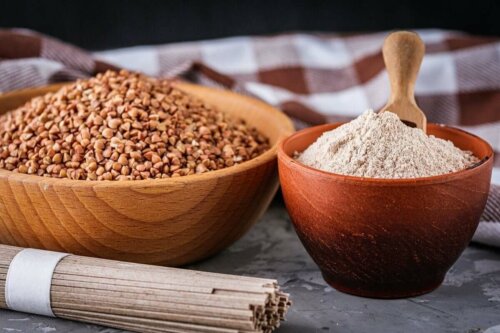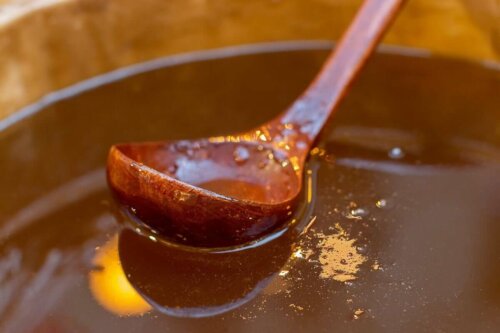Description and Properties of Buckwheat Honey


Written and verified by the nutritionist Anna Vilarrasa
Few people know that there are over 300 types of honey and probably haven’t even heard about the buckwheat kind. It’s dark in color and its flavor and aroma resemble molasses.
This natural substance is made by bees from the pollen collected from plants. It’s been a treasure for centuries. In fact, the Greeks, Egyptians, Mayans, and Babylonians were already aware of its nutritional properties so they used it for medicinal purposes.
It has a high content of antioxidants, vitamins, and minerals. Also, we know that honey promotes wound healing, soothes coughs, and helps against infections. Below, we’ll tell you more about the characteristics of buckwheat honey and how to use it in your daily life.
What’s buckwheat?
This name often confuses people. It isn’t related to the common wheat and it isn’t a cereal. Buckwheat (Fagopyrum esculentum) is the grain of a plant in the Polygonaceae family. Its fruits have a triangular shape and a dark color.
The cultivation of buckwheat is widespread throughout much of the world but is highly concentrated in Europe, Russia, the United States, and Asia. One of its strong points is that it doesn’t contain gluten and you can use it as you would a cereal.
There are many typical dishes made with this ingredient in some countries. The Japanese soba noodles, the Galettes Bretonnes (salty crepes typical of Brittany), the blinis in Eastern Europe, or the kasha in Russia, for example.

Characteristics of buckwheat honey
Buckwheat honey has different characteristics from the other better-known varieties like thousand flowers, rosemary, or eucalyptus.
Its color may vary a little depending on the time and place of the collection of buckwheat pollen. Its shades range between coppery yellow and black but the most common color is a reddish amber.
The sweet flavor predominates, of course, although it isn’t as sweet as most kinds of honey. It also has a bitter aftertaste that makes it a bit scratchy on the palate. This type of aromatic honey may remind you of beer, bread, or sugar cane.
In general, its consistency is viscous and not very fluid and tends to crystallize quickly. It’s a bit thick, similar to softened butter.
Benefits and uses of buckwheat honey
Carbohydrates are the main component of this kind of honey but it also contains vitamins, minerals, organic acids, flavonoids, polyphenols, and some volatile compounds. What are its main benefits? Well, let’s look at them in detail.
It’s an adjuvant in the treatment of scars and burns
The use of honey as a topical remedy for wounds is well-known. You shouldn’t apply it to open wounds, but it’s useful in ulcers, sores, and scratches. Humans value it because it helps stop the growth of bacteria on the skin surface.
Antioxidant activity
This happens due to its phenol content. At the moment, studies show an increase in antioxidant components in the blood but the exact role they play in the human body is still unknown.
Anyway, we do know that antioxidants have a determining role in the prevention of premature aging and associated diseases.
Protection of the intestinal microbiota
The results of research presented in the journal Evidence-Based Complement Alternative Medicine indicate that buckwheat honey can provide benefits to the human gut. In particular, it feeds the positive bifidobacteria that inhabit the colon. In addition, it restricts the growth of those pathogens.
Recent scientific evidence indicates the importance of intestinal microbiota for your health. Being in good shape here improves brain function, the immune system, and your nutritional status.
Antimicrobial and antiviral capacity
Honey can have a positive effect against common pathogens in hospital environments due to its high content of sugar.
Scientists have analyzed its specific activity against the following microorganisms:
- Clostridium difficile
- Staphylococcus aureus
- Two types of Pseudomonas aeruginosa
- Enterococcus faecalis
- Klebsiella pneumoniae
These scientists focused their research on Wisconsin honey, and their conclusion is that you can use it along with other therapeutic resources against resistant pathogens. There’s not enough evidence to support this claim, though.

Improvement of the common cold
Buckwheat honey, like common honey, appears to be an adjuvant in the treatment of common cold symptoms. It helps soothe coughing and improves sleep quality, especially in children.
Find out how to use Sage and Honey to Treat Cuts and Scrapes
Culinary recommendations
One of the most common and widespread ways of using honey is by adding it to herbal teas or hot infusions. All you need to do is dilute it in a hot beverage.
However, don’t exceed the recommended dose of one teaspoon per cup for adults and half a teaspoon for young children. Also, it’s very important that you know its use isn’t suitable for children under one year of age due to the possibility of botulism.
It’s usually a good sweetener that can easily replace regular sugar. Add a teaspoon to dishes or desserts such as:
- Oat porridge
- Yogurt
- Cottage cheese and nuts
- Orange and cinnamon
The ability of honey to attract water is great for cakes, buns, and pastries. It makes them moister and, thus, more special and pleasant to the taste.
You can also make a spongier bread by mixing it in a dough with yeast. It’s also a great breakfast or snack spread on toast.
Use it in savory recipes that can benefit from a sweet touch such as:
- Vinaigrettes with mustard, red wine vinegar, or mayonnaise
- Fish, meat, or tofu marinades
- Caramelized nuts and seeds
Do you know The Glycemic Index of Honey and Diabetes?
Buckwheat honey, a healthy option
Buckwheat honey has a different color, texture, and flavor than other kinds of honey. Even so, it’s a nutritious product you can easily incorporate into your diet in moderate amounts.
It’s great in both sweet and savory dishes and also in herbal infusions, teas, or simple water.
At a topical level, you can apply it to wounds and superficial burns since it aids the healing process and prevents infections. Just apply a thin layer on the desired area and cover it with a clean bandage. Are you ready to try it?
All cited sources were thoroughly reviewed by our team to ensure their quality, reliability, currency, and validity. The bibliography of this article was considered reliable and of academic or scientific accuracy.
- Hammond EN et al. Effect of United States buckwheat honey on antibiotic-resistant hospital acquired pathogens. Pan African Medical Journal. Diciembre 2016.25:212.
- Fashner J. et al. Treatment of the Common Cold in Children and Adults. American Family Physician. Julio 2012. 86(2):153-159.
- Jiang L et al. Phenolics and Carbohydrates in Buckwheat Honey Regulate the Human Intestinal Microbiota. Evidence Based Complement Alternative Medicine. Febrero 2020:6432942.
- Lai-flurrie K. Honey in wound care: effects, clinical application and patient benefit. British Journal of Nursing. Septiembre 2013. 17(5).
-
Geldof N. et al. Journal of Agricultural and Food Chemistry. Enero 2003. 51 (5):1500–1505.
- Van den Berg A.J.J et al. An in vitro examination of the antioxidant and anti-inflammatory properties of buckwheat honey. Journal of wound care. Septiembre 2013. 17(4):
This text is provided for informational purposes only and does not replace consultation with a professional. If in doubt, consult your specialist.








